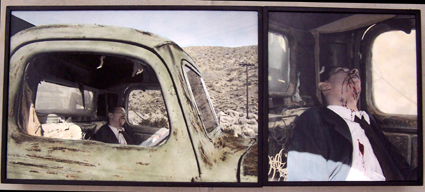Galeria Leme presents works by four distinct artists, creating a dialogue among the pieces.
Fernanda Chieco, Brazilian – The new series of drawings ‘Brave Vulture’ continues to establish relationships between human bodies in the work of this young 29-year-old artist. ‘I’m constantly researching human anatomy, 14th-century medical manuscripts, the functioning of machines and complex mechanisms in general, myths, and legends,’ she explains. The vultures allegedly bring balance to Fernanda’s drawings; the rich and colorful form of the animal interacts with the sensuality of the women, created through the artist’s light touch. The somber tone of these animals and the weapons carried by some of her characters, like a grenade and a pistol, stand in contrast to the serene expression of her women. In the series ‘Iscas,’ Fernanda provides instructions on how to get rid of insects or provide food for her vultures. ‘Iscas’ consists of ten drawings accompanied by objects.
Neil Hamon, English – Morbidity is more openly exposed in Hamon’s photographs, displayed alongside Chieco in the main gallery hall. He presents a series of images of his own suicide, based on crime scenes from 1920s America. ‘Hanging’ and ‘Overdose’ consist of a group of images presenting different details of this moment from various angles. The style is similar to the early days of photos and records of crime scenes, akin to that of the ‘father’ of forensic photography – Alphonse Bertillon. The images are nonlinearly arranged, a format commonly used in contemporary cinema. Hamon’s work lies between documentary and theatrical presentation.
Benji Whalen, American – Whalen presents his well-known work of embroidered tattoos on fabric arms, where tattoo subculture appears more delicately but with a strong sensual appeal, addressing themes like sex, death, politics, and religion. His work merges the masculine and feminine in various ways. Traditionally, embroidery is seen as a feminine attribute and was used in the 1970s by feminist artists to punctuate a form of expression. Through his embroidery, Whalen deliberately expresses the aggressiveness of the male imagination. He blends the softness of the fabric with the rigidity of the needle, which is also used to tattoo on the skin.
Renato Dib, Brazilian – Dib, who presents his work on the gallery’s mezzanine, uses embroidery more poetically. His creations with soft, pale colors transcend the original fabric and emerge in collages and watercolors, resembling a patchwork quilt or fragments of a more soothing cloak, without losing restlessness and sensuality.
